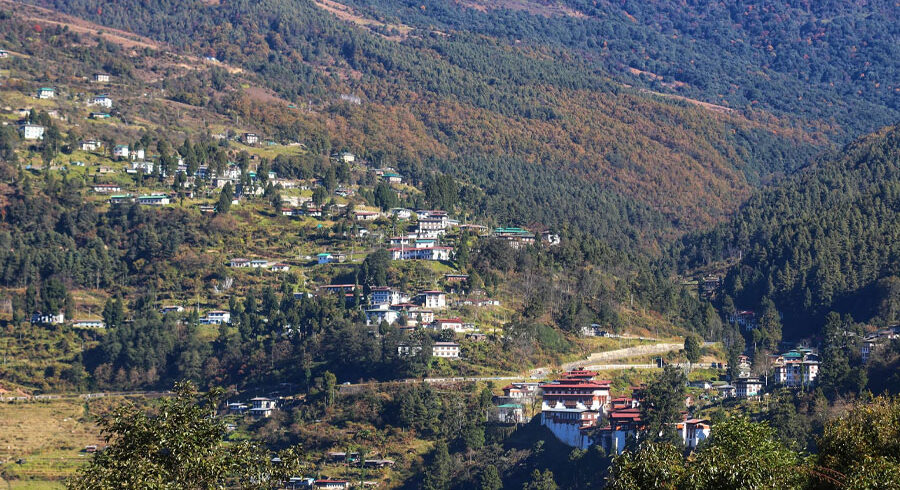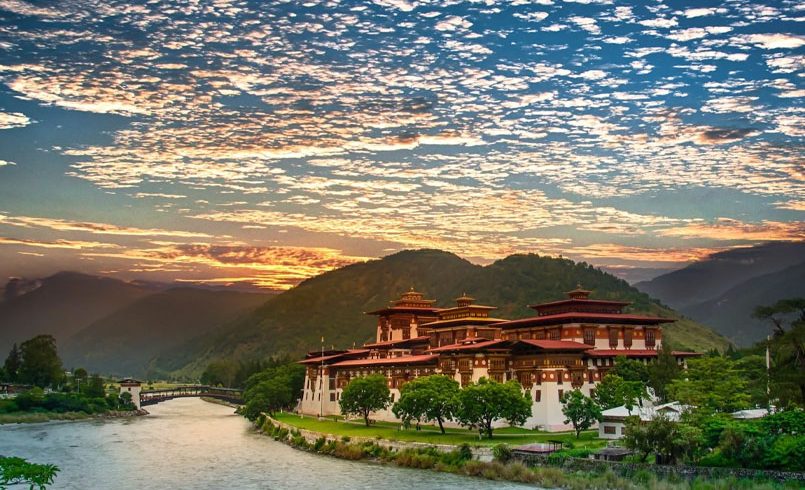Overview
Breakfast at your hotel then drive up into the mountains and the spectacular Dochula pass at a height of around 3140m. If the weather is clear you will be able to enjoy superb views over the high Himalayan mountain peaks.
Here you can also take a 3 hour trek to Lhuenchutse monastery several hundred meters above the Dochula pass. A late lunch or afternoon tea will be served at the Dochula Resort.
On the way to Punakha, visit Chimey Lhakhang located on a hillock in the centre of the valley below Metsina. Built in 1499 the temple is also known as “the Temple of Fertility”. A wooden effigy of the lama’s thunderbolt is preserved in the lhakhang, and childless women go to the temple to receive a blessing.
Highlights
- Explore the remote eastern villages known for simple lifestyle.
- See women weaving tapestry of textiles.
- Ancient temples, Dzongs and towns.
- Experience typical Bhutanese dinner and drinks with local host.
- Spectacular hike to Tiger's Nest Monastery.
Itinerary
Upon arrival at Paro International Airport, you will be met by your guide and transferred to your hotel in Thimphu, Bhutan’s beautifully located capital city which is about 45 minutes drive (53km) from the airport.
Lunch will be served at your hotel.
In the afternoon visit the Tashichho Dzong, the beautiful medieval fortress/monastery which houses most of the Government’s office and King’s Throne room. It is also the summer residence of Je Khenpo, the Chief Abbot. Then visit the National Library which has a vast collection of ancient Buddhist texts and manuscripts. After that, drive to Painting School, famous for traditional thangkha paintings. Here you will see students at work producing intricate design on cloth. If time permits, also visit the Traditional Medicine Institute.
Dinner and overnight at your hotel.in Thimphu
Breakfast at your hotel, then a scenic drive into the upper reaches of the Wang Chhu Valley which is home to both the Tango and Cheri Monasteries. Here you will have the chance to visit one or both of these amazing monasteries which are located high on adjacent hillsides surrounded by lush forests.
Dinner and overnight at your hotel in Thimphu.
Breakfast at your hotel then drive up into the mountains and the spectacular Dochula pass at a height of around 3140m. If the weather is clear you will be able to enjoy superb views over the high Himalayan mountain peaks.
Here you can also take a 3 hour trek to Lhuenchutse monastery several hundred meters above the Dochula pass. A late lunch or afternoon tea will be served at the Dochula Resort.
On the way to Punakha, visit Chimey Lhakhang located on a hillock in the centre of the valley below Metsina. Built in 1499 the temple is also known as “the Temple of Fertility”. A wooden effigy of the lama’s thunderbolt is preserved in the lhakhang, and childless women go to the temple to receive a blessing.
Dinner and overnight at your hotel in Punakha.
Breakfast at your hotel.
Take a 45 minute walk to a chorten or stupa at Nyizergang followed by a visit to the amazing Punakha Dzong which was built in 1637. This impressive Dzong is situated between Pho Chu (Male River) and Mo Chu (Female River). The Punakha Dzong was the second of Bhutan’s dzongs and until the mid-1950s, it served as the seat of the government. It is also the winter residence of Je-Khenpo and the Central Monastic Body.
After lunch, drive through to Gangtey.
Dinner and overnight at your hotel in Gangtey.
After breakfast at your hotel, take a leisurely walk through Gangtey village and then along a nature trail through the Phobjikha valley. This glaciated valley on the western slopes of the Black Mountains is the winter home for a large flock of black-necked cranes. In addition to the cranes, there are also muntjacs (barking deer), wild boars, sambars, Himalayan Black bears, leopards and red foxes in the surrounding hills.
Lunch at your hotel then drive through to Trongsa.
Dinner and overnight at your hotel in Trongsa.
Breakfast at your hotel, and then visit Trongsa Dzong, which is probably the most impressive dzong in Bhutan. It was built in its present form in 1644 and it is the ancestral home of the present Royal Family. Here you may also have a chance to see Bhutanese archers playing their favourite sport.
After lunch drive through to Bumthang in the central heart of Bhutan.
Dinner and overnight at your hotel in Bumthang.
After breakfast at your hotel, visit Jambay Lhakhang Kurje Lhakhang, Tamshing Lhakhang, and Kenchosum Lhakhang plus the Jakar Dzong,
Lunch at your hotel and then a very scenic drive through to Ura, a traditional village in Central Bhutan. On the way, visit Membar Tsho, the Burning Lake.
Dinner and overnight at your guest house in Ura.
Have breakfast at your guest house before driving about 15km to the tiny settlement of Gayzamchu to commence a full day trek back to Ura. Return to Bumthang.
Dinner and overnight at your hotel in Bumthang.
Breakfast at your hotel, and then take the mountain road back to Thimphu. You will be able to have a short stop at Wangdue Phodrang if time permits.
Dinner and overnight at your hotel in Thimphu
Breakfast at your hotel, then drive to the forested edge of Thimphu to commence a five hour return trek to the Phajoding Monastery – which dates from the 13th century. The route climbs 1,100m through rhododendron forests to the monastery at 3,600m above sea level. The resident monks will welcome you to their place of worship – and a picnic lunch will be served. This day walk is actually the first part of the famous Druk Path trek between Thimphu and Paro.
Dinner and overnight at your hotel in Thimphu.
After breakfast, drive through to Paro to visit Simtokha Dzong, built in 1627 and also to visit the ruins of Drukgyal Dzong which was built in 1644 to commemorate the victory over the Tibetan invaders. The dzong was used as an administrative centre until 1951 when a fire caused by butter lamp destroyed it. Then visit Kyichu Lhakhang, one of Bhutan’s oldest and most sacred monasteries dating from the introduction of Buddhism in the 8th century and also visit the Rimpung Dzong built in 1646.
Dinner and overnight at your hotel in Paro.
After breakfast, take a short drive to the base of the famous Taktshang Monastery or Tiger’s Nest, which clings to a sheer rock face at a height of 2600m above sea level. The climb is quite steep, but ponies are available for those who feel they cannot make the climb themselves.
The main temple was built around Guru Rinpoche’s meditation cave in 1684 This incredible monastery clings to the edge of a sheer rock face which plunges 900 meters into the valley below. Legend has it that Guru Padmasambhava, the tantric mystic who brought Buddhism to Bhutan in 747 AD, flew here on the back of a flying tiger, Dorje Drolo.
After lunch, visit Ta Dzong an ancient watchtower, which now houses the National Museum. Below the museum is the Rinpung Dzong (literally meaning “Heap of Jewels”), the centre of civil and religious authority in this valley, built in 1646.
Dinner and overnight at your hotel in Paro.
After breakfast drive to Paro International Airport for your departure from Bhutan.
Cost
The Cost Includes
- Sustainable Development Fee (SDF)
- Accommodation
- All meals
- Transport
- All internal taxes & charges
- Licensed Bhutanese Tour Guide
- Equipment & haulage for trekking tours
The Cost Excludes
- Flight tickets
- Insurance
- Drinks and Beverages
- Tips
- Internet and Phone bills
- Other bills of personal nature
FAQs
Yes, if you are traveling with a group of friends or with your family, you can customize your own Bhutan group tour. Please contact your professional travel consultant to discuss and arrange a customized group tour thatmeets your needs and preferences.
Climate: The ideal seasons for travel in Bhutan are from March to November when the weather is most suitable.
Off-peak season: From December to February, it is winter and considered the off-peak travel period. During the day, temperatures hover around 15 degrees Celsius, dropping below freezing at night. From June to September, it is summer and the rainy season, with temperatures around 23 degrees Celsius during the day and 15 degrees Celsius at night.
Peak season: The peak travel periods are from March to May and September to November.
In the Paro region of Bhutan, staple foods include rice, buckwheat, corn, and red rice. Chili and dairy products are commonly used as accompaniments. One of the most famous traditional dishes is Emma Datshi, which consists of chili with cheese. While beef, lamb, and pork are popular meats, it’s important to note that Bhutan follows Buddhist principles of non-violence and does not slaughter animals within the country. Most of the meat available in the market is imported from neighboring India and primarily caters to tourists. Beverage options include black tea, butter tea, rice wine, and beer.
Yes, you can charge batteries en route. Charger should be brought. There are hot shower facilities as well. You may have to pay a certain amount for both ($1-$2). Negotiate. Also, a hot water facility could be free at a lower elevation.
Respect for Customs and Regulations: Please show respect for Bhutan’s religious customs, traditions, and adhere to the relevant government regulations during your visit.









